Abstract
Stable Pb isotope ratios were used to trace thesources and pathways of Pb between the atmosphere,surficial sediment fractions, the white water-lilyNymphaea odorata, and waters collected at 26littoral sites in 23 Ontario lakes in summer 1993,three years after alkyl Pb additives were finallyeliminated from Canadian gasoline. Based onsimilarities of isotopic composition, the exchange ofPb between lakewater and sediment 'carbonate', andsubsequently between 'carbonate', 'oxide' and othersediment fractions, was the most likely water-sedimentpathway of Pb movement. pH controlled Pb fractionationwithin surficial sediments, with the 'organic' poolcomprising 80–97% of total Pb in most acidic lakesand 15–60% in alkaline lakes. About 28% of the Pb inN. odorata shoots was accumulated directly fromwater, whereas there was no evidence of root uptake ofPb from sediments. The Pb in plant tissues wasisotopically homogeneous and dissimilar to thevariable composition exhibited in ambient waters andsediments. Plant Pb isotopes strongly resembled thehistorical Canadian atmospheric (alkyl Pb) signature.A possible explanation is that, like essential tracemetals, historically-accumulated Pb was highlyconserved during the annual growth cycle of thislong-lived, clonal macrophyte, being storedover-winter in underground rhizomes and recycled intospring growth. Given the low rate of 'new' Pb uptake,historical alkyl Pb may continue to dominate planttissues for some time, even though it was notdetectable in littoral waters and sediments.
Similar content being viewed by others
References
Blais, J. M.: 1996, 'Using isotopic tracers in lake sediments to assess atmospheric transport of lead in eastern Canada', Water, Air, and Soil Pollut. 92, 329–342.
Brown, J. S.: 1962, 'Ore leads and isotopes', Economic Geology 57, 673–720.
Carignan, J. and Gariépy, C.: 1995, 'Isotopic composition of epiphytic lichens as a tracer of the sources of atmospheric lead emissions in southern Quebec, Canada', Geochimica et Cosmochimica Acta 59, 4427–4433.
Carroll, S. A., O'Day, P. A. and Piechowski, M.: 1998, 'Rock-water interactions controlling zinc, cadmium, and lead concentrations in surface waters and sediments, U.S. Tri-State mining district. 2. Geochemical interpretations', Environmental Science and Technology 32, 956–965.
Cook, R. E.: 1985, 'Growth and Develoment in Clonal Plant Populations', in B. C. Jackson, J. W. Buss and R. E. Cook (eds.), Population Biology of Clonal Organimsms, Yale University Press, Connecticutt, pp. 259–296.
Dickin, A. P.: 1995, Radiogenic Isotope Geology, Cambridge University Press, Cambridge, U.K., 490 p.
Everard, M. and Denny, P.: 1985, 'Flux of lead in submerged plants and its relevance to a freshwater system', Aquatic Botany 21, 181–193.
Flegal, A. R., Nriagu, J. O., Niemeyer, S. and Coale, K. H.: 1989, 'Isotopic tracers of lead contamination in the Great Lakes', Nature 339, 455–458.
Gelinas, Y. and Schmit, J.-P.: 1997, 'Extending the use of the stable lead isotope ratios as a tracer in bioavailability studies', Environmental Science and Technology 31, 1968–1972.
Graney, J. R., Halliday, A. N., Keeler, G. R., Nriagu, J. O., Robbins, J. A. and Norton, S. A.: 1995, 'Isotopic record of lead pollution in lake sediments from the northeastern United States', Geochimica et Cosmochimica Acta 59, 1715–1728.
GSC: 1996, 'Geological Map of Canada. Map 1860A, 1:5 000 000'. Geological Survey of Canada, Natural Resources Canada, Ottawa.
LaZerte, B. D., Evans, D. and Grauds, P.: 1989, 'The deposition and transport of trace metals in an acidified catchment of Central Ontario', Science of the Total Environment 87/88, 209–222.
Mayes, R. A., McIntosh, A.W. and Anderson, V. L.: 1977, 'Uptake of cadmium and lead by a rooted aquatic macrophyte (Elodea canadensis)', Ecology 58, 1176–1180.
Nelson, W. O. and Campbell, P. G. C.: 1991, 'The effects of acidification on the geochemistry of Al, Cd, Pb and Hg in freshwater environments: A literature review', Environmental Pollution 71, 91–130.
Outridge, P. M. and Hutchinson, T. C.: 1990, 'Effects of cadmium on integration and resource allocation in the clonal fern Salvinia molesta', Oecologia 84, 215–223.
Outridge, P.M. and Noller, B. N.: 1991, 'Accumulation of toxic trace elements by freshwater vascular plants', Reviews of Environmental Contamination and Toxicology 121, 1–63.
Peter, R., Welsh, H. and Denny, P.: 1979, 'The translocation of lead and copper in two submerged aquatic angiosperm species', Journal of Experimental Botany 30, 339–345.
Rapin, F., Tessier, A., Campbell, P. G. C. and Carignan, R.: 1986, 'Potential artifacts in the determination of metal partitioning in sediments by a sequential extraction procedure', Environmental Science and Technology 20, 836–839.
Reid, N.W., Kiely, P. and Gizyn, W.: 1993, 'Time Trends in Ambient Lead in Ontario', in R. J. Allan and J. O. Nriagu (eds.), Proceedings of the International Conference on Heavy Metals in the Environment, Vol. 2, Toronto, Sept. 1993, CEP Consultants, Edinburgh, pp. 223–226.
Smith, C. S., Adams, M. S. and Gustafson, T. D.: 1988, 'The importance of belowground mineral nutrient stores in cattails (Typha latifolia L.)', Aquatic Botany 30, 343–352.
Sokal, R. R. and Rohlf, F. J.: 1981, Biometry. The Principles and Practice of Statistics in Biological Research, 2nd ed., Freeman and Co., New York, 859 pp.
Sturges, W. T. and Barrie, L. A.: 1987, 'Lead 206/207 isotope ratios in the atmosphere of North America as tracers of US and Canadian emissions', Nature 329, 144–145.
Sturges, W. T. and Barrie, L. A.: 1989, 'The use of stable lead 206/207 isotope ratios and elemental composition to discriminate the origins of lead in aerosols at a rural site in eastern Canada', Atmospheric Environment 23, 1645–1657.
Tessier, A., Campbell, P. G. C. and Bisson, M.: 1979, 'Sequential extraction procedure for the speciation of particulate trace metals', Analytical Chemistry 51, 844–851.
Welsh, R. P. H. and Denny, P.: 1980, 'The uptake of lead and copper by submerged aquatic macrophytes in two English lakes', Journal of Ecology 68, 443–455.
Author information
Authors and Affiliations
Rights and permissions
About this article
Cite this article
Outridge, P.M. Lead biogeochemistry in the littoral zones of south-central Ontario lakes, Canada, after the elimination of gasoline lead additives. Water, Air, & Soil Pollution 118, 179–201 (2000). https://doi.org/10.1023/A:1005194309413
Issue Date:
DOI: https://doi.org/10.1023/A:1005194309413




